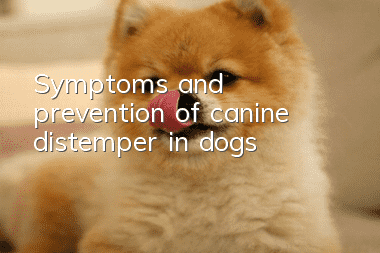Symptoms and prevention of canine distemper in dogs

Canine distemper is a very serious infectious disease. It is generally characterized by complex fever, acute nasal catarrh, bronchitis, catarrhal pneumonia, severe gastroenteritis and neurological symptoms. A few sick dogs will also develop nasal and footpad angles. A situation of excessive transformation. It is often mixed with parvovirus, canine infectious hepatitis, pneumonia, etc., so the mortality rate is extremely high. The initial stage of the disease is similar to fever and is easily ignored by parents. It manifests as conjunctivitis and dry cough, which then turns into wet cough, dyspnea, vomiting, diarrhea, intussusception, and ultimately death due to severe dehydration and weakness in the child.
Miniature Bull Terrier
Canine distemper symptoms in dogs
Canine distemper virus is the most harmful infectious disease to dogs, and it is also the one with the highest mortality rate. The cure rate is usually about 10-20%. There are many reasons for this disease. It may be because the dog itself carries the virus, improper care or sudden changes in the living environment lead to a virus outbreak in the body, or it may be due to walking the dog with other dogs carrying the virus. Dogs are infected through contact. If dogs suffer from this disease, in order to treat them in time, we should know what the symptoms of canine distemper are in dogs.
The symptoms of canine distemper are also divided into early, middle and late stages. In the early stage, you will probably have a high fever, which will quickly drop to normal temperature after 2 days. It is similar to the symptoms of a common cold. If you can treat it in time at this time, you have a better chance of getting better. is the largest. In the middle stage, there are often a series of symptoms such as persistent high fever, cough, cracked nose, runny nose, vomiting, excessive eye feces, diarrhea, etc. In the late stage, neurological symptoms such as convulsions will occur. If they reach this stage, their cure rate is It’s not high anymore, so the owner needs to be mentally prepared.
The treatment for canine distemper is generally infusion, because dogs suffering from canine distemper usually vomit whatever they eat and have almost no appetite, so they must rely on infusion to provide energy to maintain their own functions. Moreover, infusion is the best for disease treatment, because the medicine can be well absorbed by the body and achieve better healing effects.
We should have a deep understanding of the symptoms of canine distemper in dogs. After all, this is a disease that seriously harms the dog’s body, and the earlier the dog is found, the greater the chance of survival. However, if the dog is infected with this disease We also need to maintain a good attitude during illness, so we must be prepared for the possibility of the dog leaving.
Treatment and prevention of canine distemper
There is currently no effective drug treatment for canine distemper. It is difficult to cure dogs when they have obvious symptoms. Even if a few dogs survive, most will have sequelae. For sick dogs, we usually take specific and symptomatic treatments to prevent secondary infections and reduce death.
In the early stage of illness, subcutaneous or intramuscular injection of anti-canine distemper hyperimmune serum can achieve better results. Serum dosage is 2-3ml per kilogram of body weight, applied continuously for 2-3 days. Broad-spectrum antibiotics can also be used to control secondary infections, such as kanamycin, erythromycin, chloramphenicol, gentamicin, etc. To improve circulation and prevent dehydration, glucose solution and electrolytes should be supplied in large quantities. Combined with anti-inflammatory and antipyretic drugs. At the same time, cardiotonic, diuretic, and hemostatic drugs are used for comprehensive treatment. In order to protect the gastrointestinal tract, tannic acid protein and bismuth subnitrate can also be taken orally. In addition, whether you are hospitalized or treated at home, you need to prepare a warm and dry environment for it. The most important thing is that your dog should be vaccinated when it is a puppy, avoid going out during epidemics, and never come into contact with sick dogs and their excrement and vomitus.
The mortality rate of canine distemper is very high, and it is very difficult to treat in the middle and late stages of the disease. Serum antibody treatment has a certain effect in the early stage of the disease, but the effect is very poor once it reaches the middle and late stages of the disease. Therefore, infusion therapy and large doses of antibiotics, sedatives, and antiviral drugs can be used in the middle and late stages of the disease. In addition, you need to strengthen your care. Use antibiotic eye drops in your eyes and some antibiotics in your nose to keep it moist.
The course of canine distemper is very short, and it may only take a few days from onset to death. Therefore, if it is determined that the dog has canine distemper, it is not recommended to treat it at home. You must go to a professional animal hospital and receive professional help. Veterinary diagnosis and symptomatic treatment based on the dog’s illness to improve the cure rate.
Canine distemper is very harmful, so it should be prevented as soon as possible. The first vaccination for dogs is at 6 weeks of age, the second vaccination at 8 to 9 weeks of age, the third vaccination at 10 to 12 weeks of age, and the booster vaccination once a year thereafter. Vaccines currently mainly use imported canine two-, three-, five-, six- or seven-combination vaccines. Presumptively healthy dogs should be promptly injected with hyperimmune serum for passive immunization.
- How to deworm a poodle?
- What should I do if my puppy keeps barking?
- How long can a Pomeranian live with kidney failure?
- How to practice dog movements and how many months does it take?
- How to care for pet dog hair in the hot summer, a must-read for poop collectors!
- Living habits of Chinese Shar Pei dogs
- How much dog food should a two-month-old puppy eat?
- Close contact with dogs, four tips for getting rid of dog bad breath!
- How to choose dog food for elderly dogs
- How many minutes does it take for a puppy to nurse?



